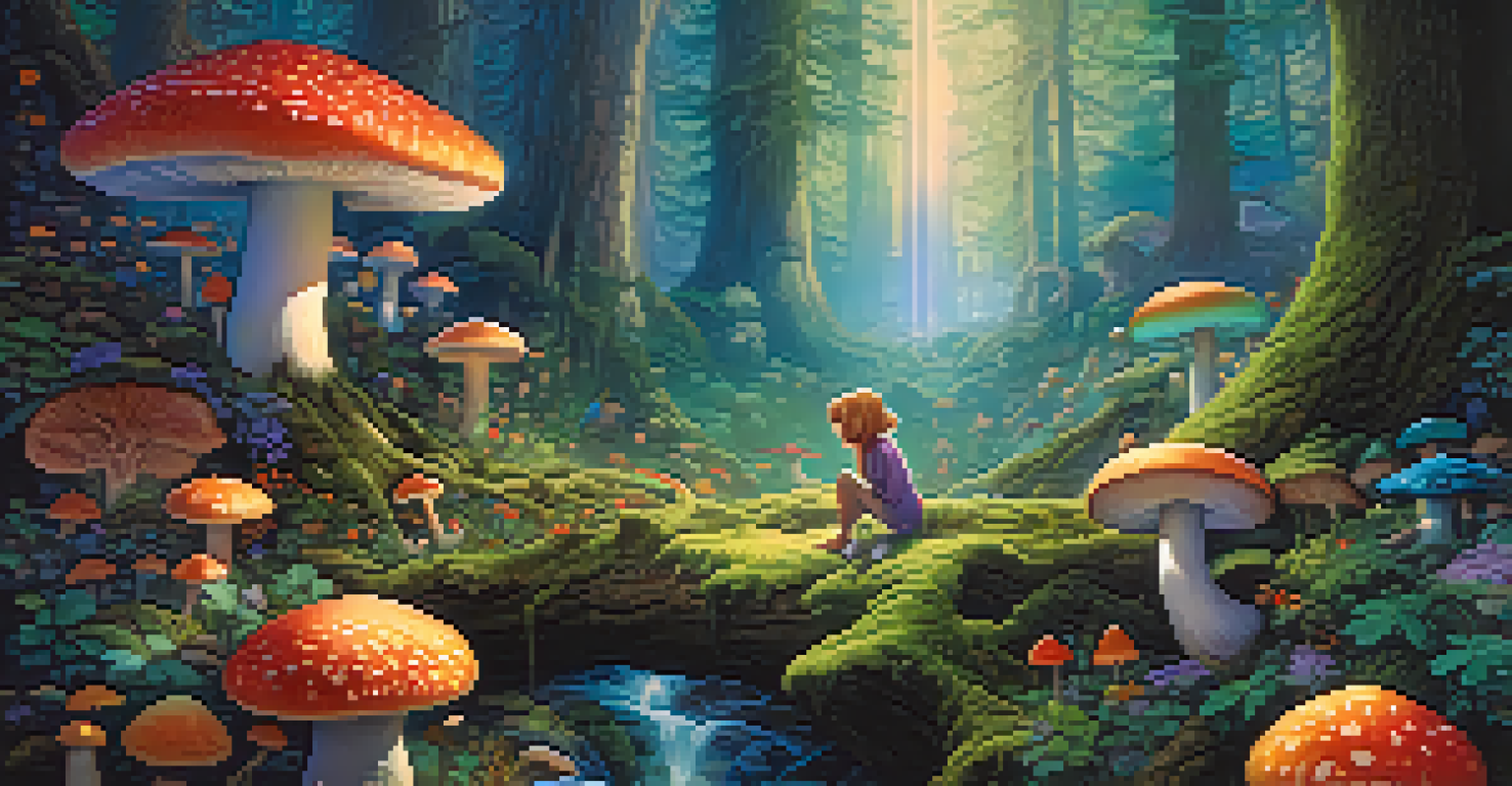Dreams as a Gateway: Entheogens and the Subconscious Mind

Understanding Dreams: What They Reveal About Us
Dreams offer a window into our subconscious, often reflecting our emotions, thoughts, and unresolved issues. They can be vivid narratives or abstract scenarios, each uniquely tied to our personal experiences. By analyzing our dreams, we gain insights into our fears, desires, and even our creativity.
Dreams are the touchstones of our character.
For example, a recurring dream about falling might symbolize feelings of insecurity or loss of control. Dreams can also provide a safe space to confront these feelings, allowing for emotional release and understanding. This process of introspection can lead to personal growth and self-awareness.
Ultimately, dreams serve as a bridge between our conscious and subconscious minds, revealing layers of ourselves we may not be fully aware of. They remind us that there is much more to our psyche than meets the eye, inviting us to explore deeper aspects of our identity.
What Are Entheogens? Exploring Their Role in Consciousness
Entheogens are substances that can induce altered states of consciousness, often leading to profound experiences of insight, unity, and self-discovery. Derived from natural sources like plants and fungi, these substances have been used in various cultures for spiritual and healing purposes. They invite users to explore the depths of their minds and connect with a larger sense of existence.

For instance, psilocybin mushrooms and ayahuasca are known for their ability to evoke intense emotional and visual experiences. People often report feeling a sense of interconnectedness or encountering profound truths about themselves and the universe. This altered state can facilitate a deeper exploration of the subconscious, similar to what dreams offer.
Dreams Reflect Our Inner World
Dreams serve as a powerful reflection of our subconscious, revealing emotions, fears, and desires.
While entheogens can be powerful tools for introspection and healing, they also require respect and caution due to their potent effects. Understanding their role in personal and spiritual development can empower individuals to navigate their experiences safely.
The Intersection of Dreams and Entheogenic Experiences
Both dreams and entheogenic experiences can serve as gateways to the subconscious, each offering unique insights and perspectives. Many users of entheogens report dream-like visions that reveal hidden aspects of themselves, mirroring the surreal nature of dreams. This overlap suggests that both phenomena might tap into the same underlying psychological processes.
The mind is everything. What you think you become.
When people use entheogens, they often find themselves confronting emotions and thoughts that were previously buried. Similar to the way dreams allow us to process daily experiences and emotions, entheogens can facilitate a deeper understanding of our psyche. This connection can enhance the therapeutic benefits of both experiences.
The interplay between dreams and entheogens can also inspire creativity and problem-solving. Just as some artists and thinkers have used dreams to spark new ideas, entheogens can provide a fresh perspective, helping individuals break free from conventional thought patterns.
How Entheogens Influence Dream States
Research suggests that entheogens can significantly influence dream states, altering the richness and recall of dreams. After using substances like LSD or DMT, individuals often report more vivid and memorable dreams, filled with complex imagery and emotional depth. This phenomenon can provide valuable insights into the user's psyche and emotional landscape.
For instance, users may find that their dreams become more intense or meaningful in the days following an entheogenic experience. Some even report experiencing lucid dreams, where they become aware of dreaming and can manipulate the dream narrative. This ability can empower individuals to confront fears or explore desires in a controlled environment.
Entheogens and Consciousness
Entheogens can induce altered states of consciousness, facilitating deep self-discovery and emotional insight.
Such changes in dream patterns highlight the interconnectedness of our conscious and subconscious experiences. By understanding how entheogens impact dreams, we can better appreciate their potential for personal transformation and healing.
The Therapeutic Potential of Dreams and Entheogens
Both dreams and entheogens have garnered attention for their therapeutic potential, especially in addressing mental health issues like anxiety, depression, and PTSD. Dream analysis can provide a non-invasive way to access and process deep-seated emotions, while entheogens are being explored for their ability to create profound breakthroughs in therapy.
For example, studies have shown that psilocybin can help individuals confront trauma and gain new perspectives, leading to lasting changes in their mental health. Similarly, dream therapy can help individuals articulate their fears and hopes, facilitating healing through self-discovery. Together, these approaches encourage holistic healing by integrating the mind, body, and spirit.
The combination of dreaming and entheogenic experiences offers a rich landscape for exploration and healing. As more people seek alternative therapies, this intersection highlights the potential for profound personal transformation.
Cultural Perspectives on Dreams and Entheogens
Throughout history, various cultures have recognized the significance of dreams and entheogens in understanding the self and the universe. Indigenous communities, for instance, have long used entheogens as part of spiritual rituals, believing these substances connect them to their ancestors and the divine. Dreams, too, have been seen as messages from the spirit world or reflections of the soul's journey.
In many cultures, dream interpretation is a respected practice, often guiding individuals in their waking lives. The insights gained from dreams and entheogenic experiences are integrated into daily decision-making, reinforcing their importance in personal and collective narratives. This cultural reverence adds depth to our understanding of both phenomena.
Therapeutic Benefits of Both
Both dreams and entheogens hold therapeutic potential, aiding in the healing of mental health issues like anxiety and PTSD.
By examining these cultural perspectives, we can appreciate the diverse ways in which dreams and entheogens have shaped human experience. They remind us that the quest for understanding our consciousness spans generations and cultures, inviting us to explore our own beliefs and practices.
Navigating the Journey: Safety and Respect in Exploration
As we explore the realms of dreams and entheogens, it's essential to approach these experiences with safety and respect. Understanding the potential risks and benefits can help individuals navigate their journeys more effectively. This includes being aware of the legal status of entheogens and seeking guidance from experienced practitioners when needed.
Setting intentions before an entheogenic experience can also enhance its therapeutic potential, allowing for a focused exploration of the subconscious. Similarly, keeping a dream journal can help individuals track their dreams and identify patterns, fostering greater self-awareness. Both practices encourage a mindful approach to personal growth.

Ultimately, the journey into our subconscious through dreams and entheogens is deeply personal. By prioritizing safety and respect, we can ensure that these explorations lead to meaningful insights and transformative experiences.